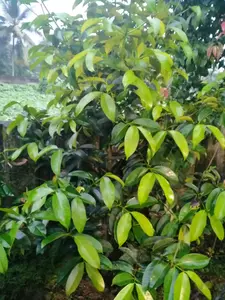
Scientific Name : Garcinia indica Choisy
Category : Angiosperms
Status : Alive
Garcinia indica uses - In particular, G. indica has been used in traditional medicine to treat inflammation, dermatitis, and diarrhea, and to promote digestion. According to several studies, various phytochemicals such as garcinol, hydroxycitric acid (HCA), cyanidin-3-sambubioside, and cyanidin-3-glucoside were isolated from G. Garcinia species are evergreen trees or shrubs, wood moderately hard, bark grey, reddish or pale gray, branches often opposite, terete, glabrous, latex usually resinous, thick, yellow in bark, branches and fruits, but sometimes cream white. Leaves simple, opposite or rarely ternate, lanceolate-ovate to oblong-oblong, base acute to obtuse, margins entire, apex acute to acuminate, chartaceous, leathery, coriaceous, glabrous on both sides, with translucent glands, midrib impressed above and prominent beneath, lateral veins irregular with parallel short veins between, veinlets reticulate, petiole slender with raised margins, exstipulate, rarely stipulate. Inflorescence axillary or terminal, in cymes, fascicles, solitary or paired. Flowers 4-5 merous, heterochlamydeous, dioecious, pseudobisexual and female ones, always less, pedicel short or sessile, sepals 4 or 5-6, imbricate, decussate in pairs, or usually persistent in fruit, petals 4, rarely 5, imbricate or contorted, alternating with sepals. Male flowers: Stamens numerous, rarely few, obscurely fascicled with 1-5 bundles, lobed mass often around a rudimentary pistil, free or connate at the base, filaments short or absent, anthers erect or peltate, 2 loculed or rarely 4, dehiscing by longitudinal slits. Female flowers: often solitary, bigger than male flowers, with minute free or united staminodes, filaments arranged in ring shape, ovary superior, globose, 2-12 locular, ovules lateral or erect, anatropus, style short or absent, stigma peltate, smooth or papillate. Fruit fleshy berry, sulcate or smooth, encased by persistent sepals. Seeds 1-12, oblong ovoid, covered with juicy cream white pulp.
Specimen Information
-
Common Name(s):
kokum
-
Synonym(s):
Garcinia purpurea Roxb.
-
Family:
Clusiaceae
About Me:
-
Created By:
admin
Botany Department (DVP College, Nimgaon Sawa) -
Created On:
16-09-2023
-
Contact:
Phone: 9960072282
Email: [email protected]
Find Location:
Photo Gallery




